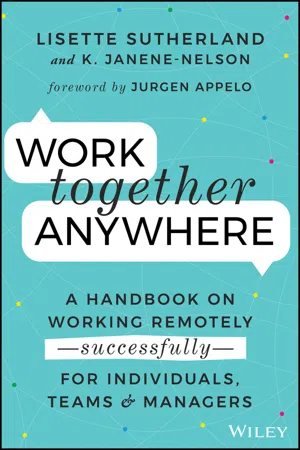
Work Together Anywhere
A Handbook on Working Remotely -Successfully- for Individuals, Teams, and Managers
- English
- ePUB (mobile friendly)
- Available on iOS & Android
Work Together Anywhere
A Handbook on Working Remotely -Successfully- for Individuals, Teams, and Managers
About this book
"An excellent guide on how teams can effectively work together, regardless of location."
—STEPHANE KASRIEL, former CEO of Upwork
IN TODAY'S MODERN GLOBAL ECONOMY, companies and organizations in all sectors are embracing the game-changing benefits of the remote workplace. Managers benefit by saving money and resources and by having access to talent outside their zip codes, while employees enjoy greater job opportunities, productivity, independence, and work-life satisfaction. But in this new digital arena, companies need a plan for supporting efficiency and fostering streamlined, engaging teamwork.
In Work Together Anywhere, Lisette Sutherland, an international champion of virtual-team strategies, offers a complete blueprint for optimizing team success by supporting every member of every team, including:
- EMPLOYEES advocating for work-from-home options
- MANAGERS seeking to maximize productivity and profitability
- TEAMS collaborating over complex projects and long-term goals
- ORGANIZATIONS reliant on sharing confidential documents and data
- COMPANY OWNERS striving to save money and attract the best brainpower
Packed with hands-on materials and actionable advice for cultivating agility, camaraderie, and collaboration, Work Together Anywhere is a thorough and inspiring must-have guide for getting ahead in today's remote-working world.
Frequently asked questions
- Essential is ideal for learners and professionals who enjoy exploring a wide range of subjects. Access the Essential Library with 800,000+ trusted titles and best-sellers across business, personal growth, and the humanities. Includes unlimited reading time and Standard Read Aloud voice.
- Complete: Perfect for advanced learners and researchers needing full, unrestricted access. Unlock 1.4M+ books across hundreds of subjects, including academic and specialized titles. The Complete Plan also includes advanced features like Premium Read Aloud and Research Assistant.
Please note we cannot support devices running on iOS 13 and Android 7 or earlier. Learn more about using the app.
Information
PART I
SETTING THE SCENE
Some of the Who, What, Where, and Why of Remote Working
CHAPTER 1
Why Are Individuals Going Remote? Workplace Flexibility
Some Terminology on Remote Working
The Five Types of Freelancers
Table of contents
- Cover
- Table of Contents
- How to Use This Book
- Foreword
- Introduction
- PART I: SETTING THE SCENE
- PART II: INDIVIDUALS WORKING REMOTELY
- PART III: SUCCESSFUL REMOTE TEAMS 101
- PART IV: SUCCESSFUL REMOTE TEAMS 201
- CONCLUSION: Doing Great Things Together
- ACKNOWLEDGMENTS: Early Adopters
- RESOURCES
- About the Authors
- INDEX
- End User License Agreement